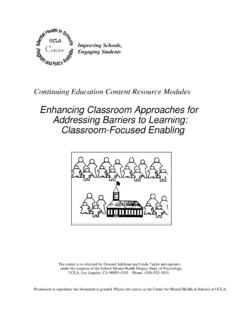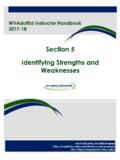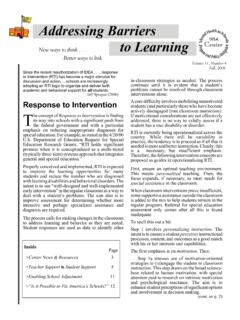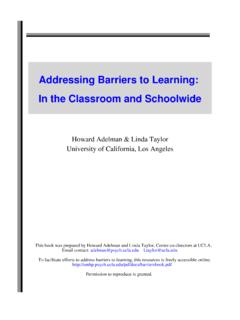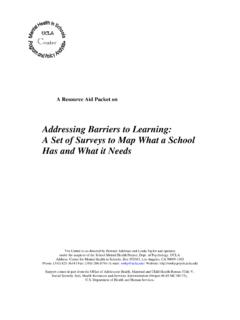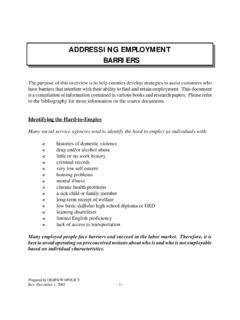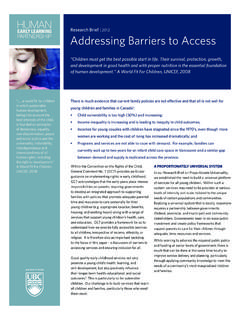Transcription of Addressing Barriers to Learning - …
1 Addressing Barriers New ways to think .. to Learning Better ways to link Volume 13, Number 4 Fall, 2008 School Dropout Prevention: A Civil Rights and Public Health Imperative As the true dropout figures emerge across the nation, the crisis nature of the problem is apparent. Recentreports indicate that more than half a million young people drop out of high school each year, and therate at which they drop out has remained about the same for the last 30 years (Dynarski, et al., 2008).The data confirm that in far too many school districts a majority of students do not have sufficient supportsto enable them to succeed at school and will not graduate. As Gary Orfield, director of the Civil Rights project has stressed: There is a high school dropout crisis far beyond the imagination of most Americans,concentrated in urban schools and relegating many thousands of minority children to a lifeof failure.
2 Only half of our nation's minority students graduate from high school along withtheir peers. For many groups Latino, black, or Native American males-graduation rates areeven lower.. this [is an] educational and civil rights crisis. In terms of economics, social programs, and public health, Russell Rumberger has pointed out that the over $192 billion in income and tax revenues for each cohort of students who never complete highschool. Relatedly, Dynarski and colleagues (2008) emphasize: Dropouts contribute only about half as much in They draw larger governmentsubsidies in the form of food stamps, housing assistance, and welfare payments. They havea dramatically increased chance of landing in prison, and they have worse health outcomesand lower life expectancies. It should be clear to everyone that schoolsexperiencing the most problems are the ones most inneed of a school improvement process that not onlydirectly improves instruction, but also includesstrategies for developing a comprehensive system ofstudent/ Learning supports (see Exhibit on next page).
3 Unfortunately, during the discussion of the impendingreauthorization of the Elementary and SecondaryEducation Act (ESEA), currently called No Child LeftBehind, most of the proposals are limited to debates Inside Page Dropout Prevention Practice Guide 6 Focusing on Intrinsic Motivation to 7Re-engage Students Center Resources 12 about standards and measures for academicaccountability. Even those that go beyond thisemphasis have not been broad enough to addresswhat is needed to enable all students to have anequal opportunity to succeed at this time, every indication is that efforts todevelop a comprehensive system of learningsupports continue to be marginalized. As ourCenter stresses in various policy and practicereports, this is true for school improvement, ingeneral, and for discussions related toreauthorizing the Elementary and SecondaryEducation Act, in particular.
4 It is clear that themany specific agenda items currently competingfor sparse resources tend to maintain theunsatisfactory status quo that characterizes the(cont. on p. 3)2 ExhibitAcademics and Beyond: A Commitment to Equity of Opportunity It is a given that a strong academic program is the foundation from which all other schoolinterventions must operate. That is, the base for equity is effective personalized instruction ( ,instructional approaches that account for both individual and group interests, strengths, andweaknesses). However, if there is to be equity of opportunity with respect to public education,policy guidelines and practices also must meet the challenge of enabling Learning by addressingbarriers to Learning and CHALLENGE Every school has a wide range of learners and must ensure equity of opportunity for all studentsand not just a few. External and internal Barriers to Learning and teaching interfere with schools achieving theirmission.
5 For the many students in need, school districts must design and implement Learning supportsystems that are comprehensive, multifaceted, and cohesive, and institutionalize them at everyschool. MEETING THE CHALLENGE Learning support systems must address Barriers to Learning and teaching and ensure thatstudents are engaged and re-engaged in classroom Learning . Such systems must reflect the bestavailable science, with a special emphasis on intrinsic motivation theory and practices. A keyfacet of this not only involves engaging students from the point at which they enter but, after afew years of schooling, also requires a strong emphasis on re-engaging those who have activelydisengaged from Learning what schools are trying to teach them. Re-engagement that isproductive of Learning is not about increasing social control, it is about promoting intrinsicmotivation (see the relevant references at the end of this article). In order to meet the goal of all children Learning to high standards or reaching proficiency, thesystem of Learning supports must be fully integrated with instruction.
6 Developing a comprehensive system of Learning supports requires weaving together theresources of school, home, and community. This involves an operational infrastructure thatensures the Learning supports system is treated as primary and essential in planning schoolimprovement. Equity requires developing a comprehensive system of Learning supports in every school in adistrict. Engagement and re-engagement at school (for students, staff, parents, and other stakeholders)requires empowerment of all and use of processes that equalize power and ensure equity andfairness in decision making. Equalizing power among stakeholders involves contractualagreements, and considerable capacity s efforts to address major Barriers to Learning ,development, and teaching. Thus, for many of us, the critical question at thisjuncture is how to coalesce strategically around aunifying concept. A united effort is the key tobreaking through the policy barrier preventing anappropriate exploration of what must happen so thatall students truly have an equal opportunity to succeedat Prevention ResourcesSchool staff and their community colleagues cannotwait for Congress to reauthorize the ESEA.
7 So, weoffer the following brief comments and someresources related to preventing student dropout. Be proactive prevent problems rather thanwait for failure. School factors can account forapproximately two-thirds of the differences inmean school dropout rates. Available researchsuggests that being held back is the singlestrongest predictor of dropping out for bothearly and late dropouts. Data indicate that beingheld back one grade increases the risk ofdropping out later by 40 to 50 percent, twogrades by 90 percent. Below are resources thatprovide an overview on the topic of dropoutprevention, including alternatives to retention. >See the Center's intro packet on dropouts >See: Youth in Transition publications/research/2002-000121 Rethink classroom and school-wide approachesto (a) enhance engaged, personalized learningand (b) provide students the Learning supportsthey need to succeed.
8 For prevention to beeffective, schools must engage all students inlearning. Doing this involves practices based onunderstanding intrinsic motivation and that useclassroom assessments that inform personalizedintervention ( , response to intervention). Children at-risk need to be identified at ayoung age (as early as preschool). At every ageinterventions are needed to ensure students feelcompetent to succeed at school. Some needone-on-one support for a while. Specialattention must be given to re-engaging thosewho have disengaged from classroom Learning . >See Enhancing Classroom Approaches for Addressing Barriers to Learning : Classroom-Focused Enabling Enhance the professional development ofteachers and support staff. Ensure teachershave the knowledge and skills to ensure awider range of students meet that support staff know how to teamwith teachers in the classroom to rethinkengagement, personalized intervention, andspecial assistance.
9 >See Preparing All Education Personnel to Address Barriers to Learning & Teaching Provide out-of-school opportunities. Effortsusing out-of-school opportunities to retainmiddle and high school students begin include tutoring, mentoring, servicelearning, career advising, and more. Whenolder students (including potential dropouts)work with younger ones, both can improvetheir literacy Learning , for example, integratescommunity service into the academiccurriculum. Investigators have found thatwhen rigorous study in academic disciplinesis linked to serious work on real needs,students' motivation to learn teachers are rigorous about partneringwith young people to design and carry outservice- Learning projects that are tied tocurricular objectives and standards, thereare academic, intellectual, civic, ethical,social, and personal benefits. >See Quick Find on After-school Programs Offer multiple pathways.
10 Students needalternative career and vocational pathwaysthat reflect high standards. The concept ofmultiple pathways focuses on ensuringchoice among a variety of high schoolprograms that prepare all students for bothcollege and careers. The emphasis is onproviding both academic and careerfoundations for advanced Learning , training,and effective and responsible participation insociety. Available choices reflect studentinterests and community strengths andopportunities. They include programs thatprovide real world training in areas wheregraduates can apply for living-wage jobs. >See Multiple Perspectives on Multiple Pathways Introduce non-traditional approaches. Educ-ational alternative programs provide a non-traditional approach by utilizing alternativeteaching strategies. Programs focus upon theneeds and interests of students by offeringpositive school experiences, which are gearedfor achievement, enhancement of positive self-concept, motivation, reduction of truancy, andreduction of disruptive behavior.
